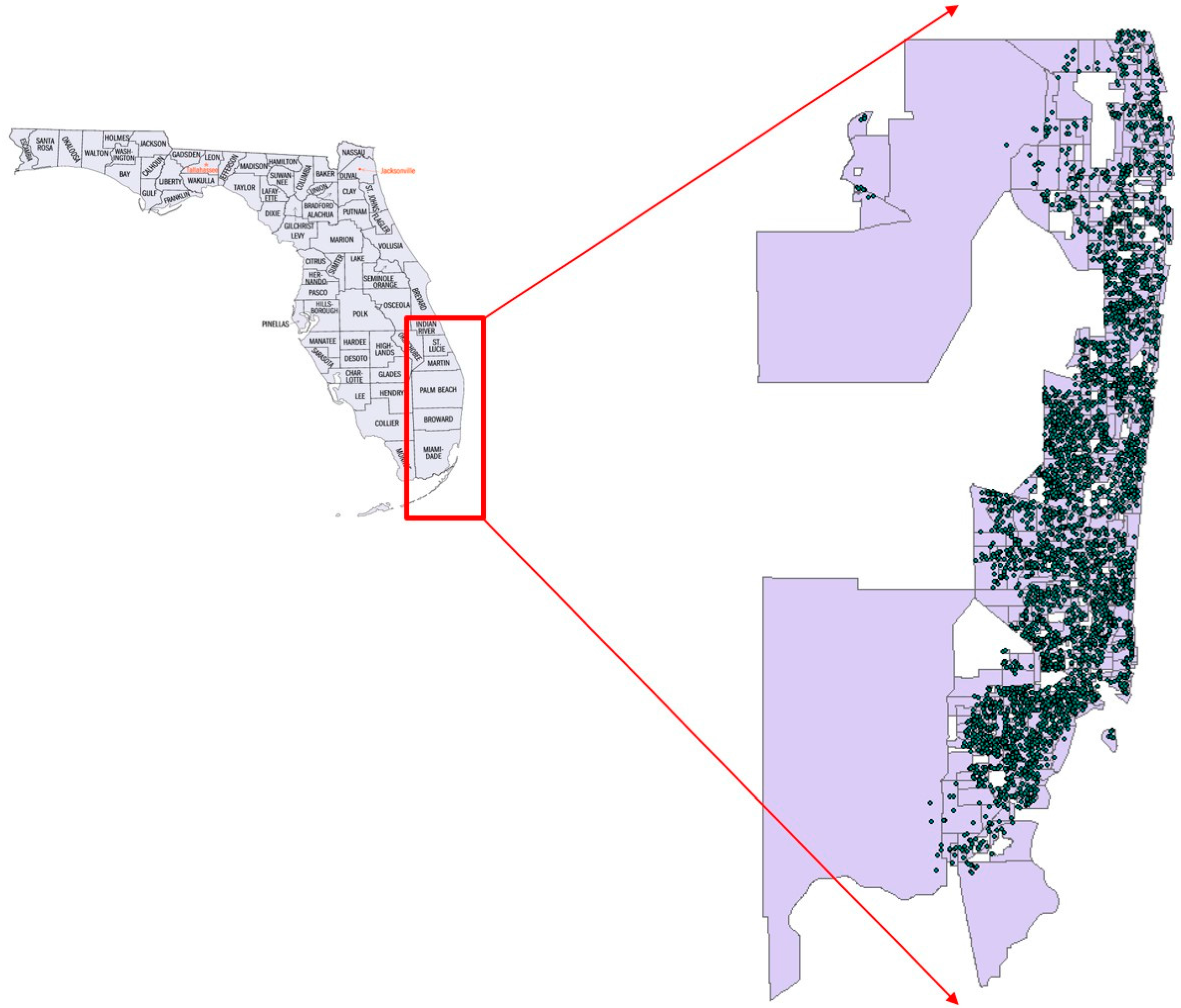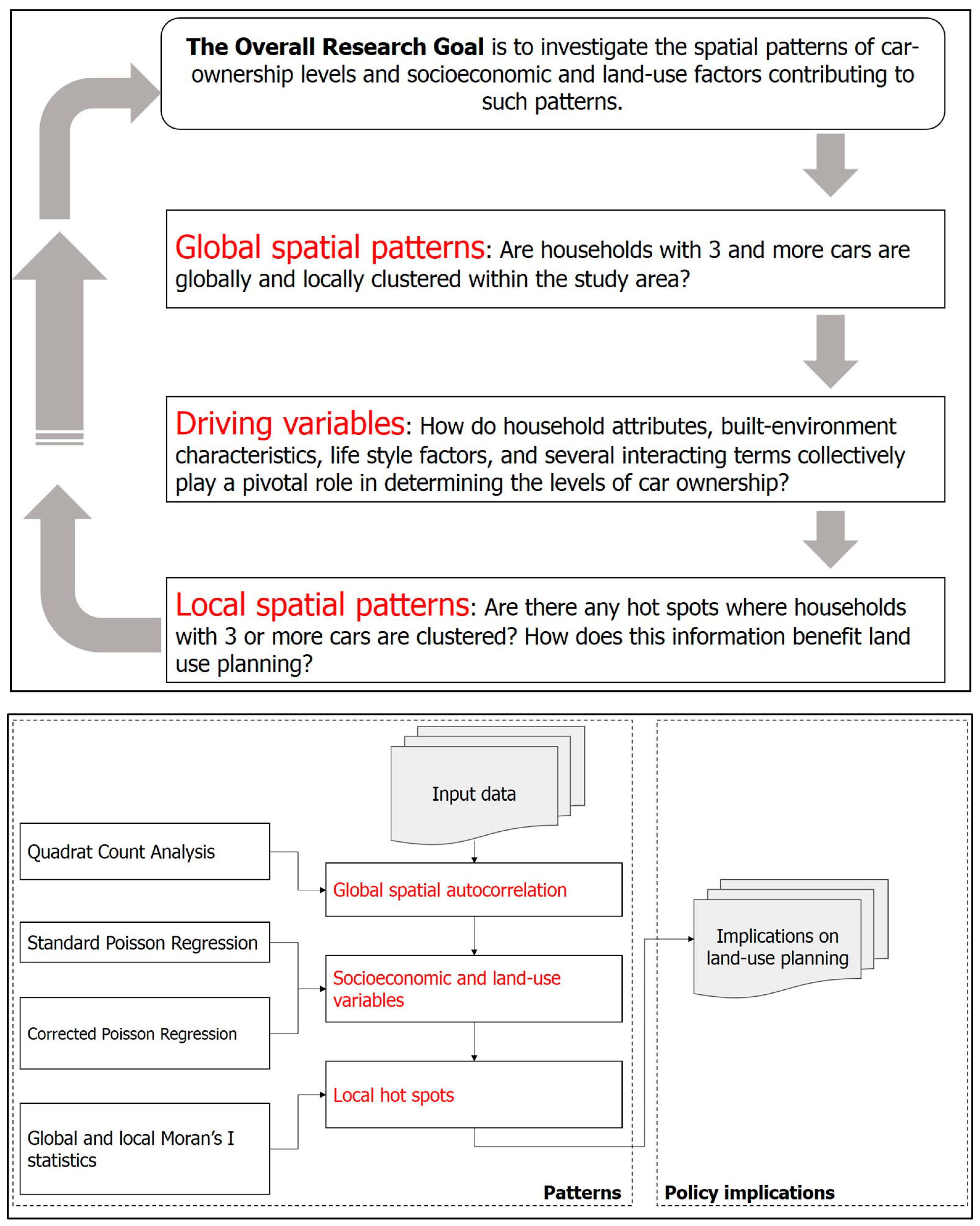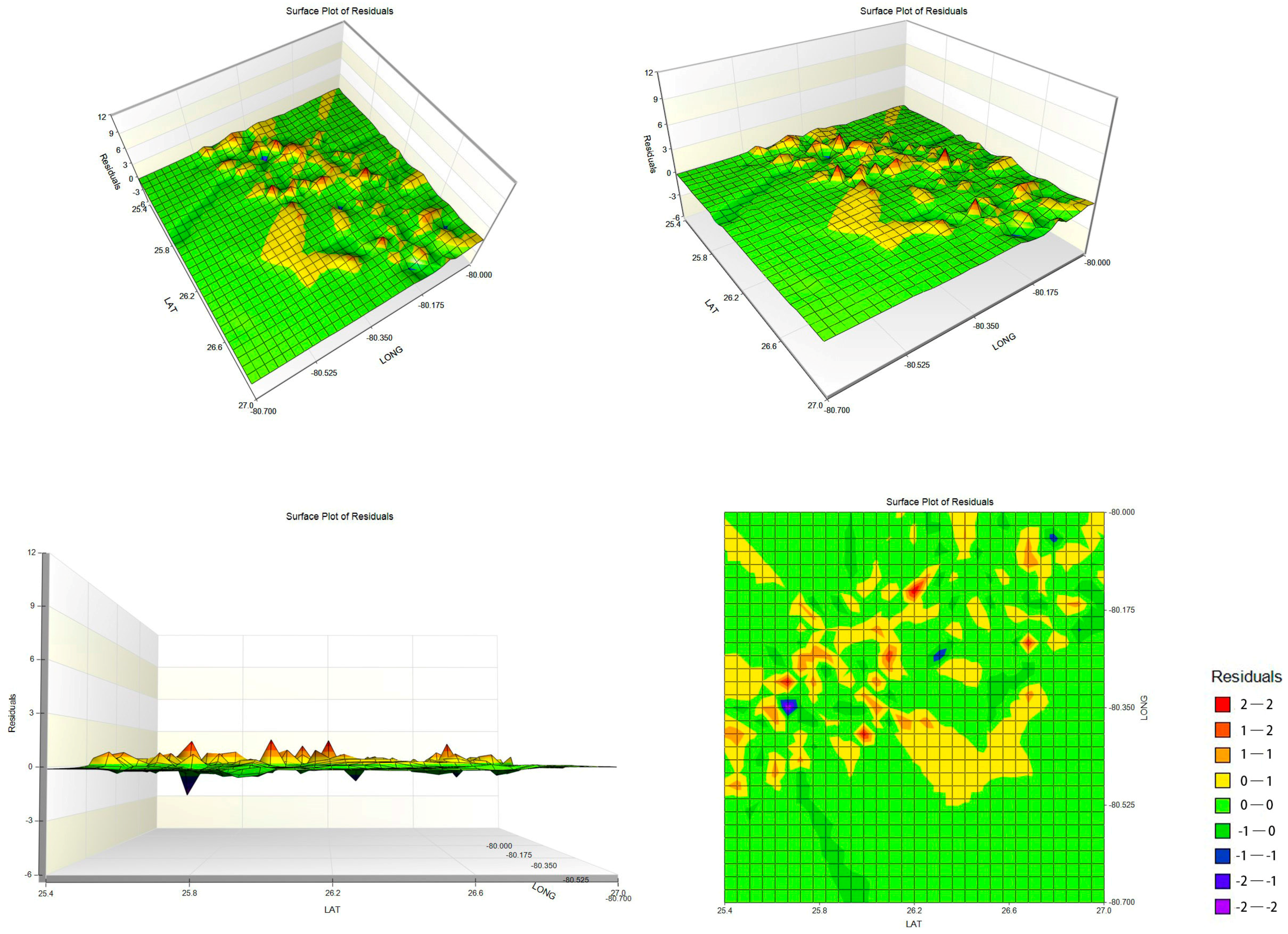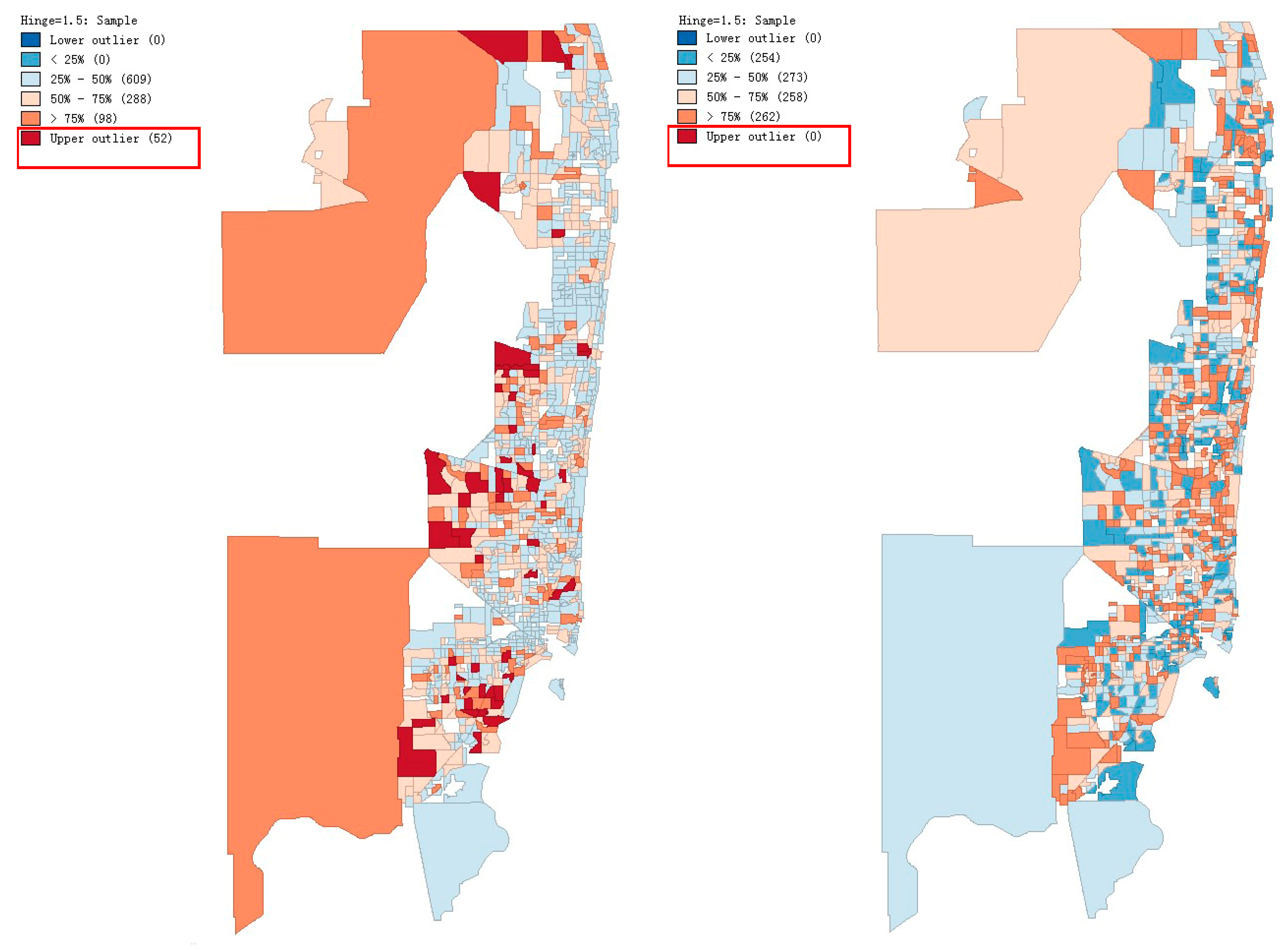Measuring the Spatial Dimension of Automobile Ownership and Its Associations with Household Characteristics and Land Use Patterns: A Case Study in Three Counties, South Florida (USA)
Abstract
:1. Introduction
2. Background
3. Research Hypotheses
- (1)
- Households with three or more private cars are globally and locally clustered in a metropolitan region.
- (2)
- Household attributes, built-environment characteristics, life style factors, and several interacting terms collectively play a pivotal role in determining the level of a household’s car ownership.
4. Data Description and Model Specifications
4.1. Data Sources and Descriptive Statistics
4.2. Model Specifications
4.2.1. Quadrat Count Analysis
4.2.2. Poisson Regression Analysis
4.2.3. Spatial Clustering Analysis
5. Empirical Results
5.1. Quadrat Count Analysis
5.2. Poisson Regression Results
5.3. Spatial Clustering Results
5.3.1. ‘Hot spot’ Detection Using the Global/Local Moran I Statistics
Global Moran’s I Statistics Based on Raw Data and Standardized Data
Local Moran’ I Statistics Based on Raw and Standardized Data
6. Discussion and Conclusions
Acknowledgments
Author Contributions
Conflicts of interest
References
- Chen, X.J.; Zhao, J.H. Bidding to drive: Car license auction policy in shanghai and its public acceptance. Transp. Policy 2013, 27, 39–52. [Google Scholar] [CrossRef]
- Whelan, G. Modelling car ownership in Great Britain. Transp. Res. Part A Policy Pract. 2007, 41, 205–219. [Google Scholar] [CrossRef]
- Li, W.C.; Bai, H.T.; Yin, J.F.; Xu, H. Life cycle assessment of end-of-life vehicle recycling processes in China-take corolla taxis for example. J. Clean. Prod. 2016, 117, 176–187. [Google Scholar] [CrossRef]
- Wu, T.; Zhao, H.M.; Ou, X.M. Vehicle ownership analysis based on GDP per capita in China: 1963–2050. Sustainability 2014, 6, 4877–4899. [Google Scholar] [CrossRef]
- Woods, L.; Ferguson, N.S. The influence of urban form on car travel following residential relocation: A current and retrospective study in Scottish urban areas. J. Transp. Land Use 2014, 7, 95–104. [Google Scholar] [CrossRef]
- Commins, N.; Nolan, A. Car ownership and mode of transport to work in Ireland. Econ. Soc. Rev. 2010, 41, 43–75. [Google Scholar]
- Anowar, S.; Yasmin, S.; Eluru, N.; Miranda-Moreno, L.F. Analyzing car ownership in Quebec City: A comparison of traditional and latent class ordered and unordered models. Transportation 2014, 41, 1013–1039. [Google Scholar] [CrossRef]
- Joh, K.; Chakrabarti, S.; Boarnet, M.G.; Woo, A. The Walking Renaissance: A Longitudinal Analysis of Walking Travel in the Greater Los Angeles Area, USA. Sustainability 2015, 7, 8985–9011. [Google Scholar] [CrossRef]
- Zhu, C.; Zhu, Y.L.; Lu, R.Z.; He, R.; Xia, Z.L. Perceptions and aspirations for car ownership among Chinese students attending two universities in the Yangtze delta, China. J. Transp. Geogr. 2012, 24, 315–323. [Google Scholar] [CrossRef]
- Belgiawan, P.F.; Schmocker, J.D.; Fujii, S. Understanding car ownership motivations among Indonesian students. Int. J. Sustain. Transp. 2016, 10, 295–307. [Google Scholar] [CrossRef]
- Xu, B.; Lin, B.Q. Regional differences of pollution emissions in China: Contributing factors and mitigation strategies. J. Clean. Prod. 2016, 112, 1454–1463. [Google Scholar] [CrossRef]
- Chin, A.; Smith, P. Automobile ownership and government policy: The economics of Singapore’s vehicle quota scheme. Transp. Res. Part A Policy. Pract. 1997, 31, 129–140. [Google Scholar] [CrossRef]
- Smith, P. Controlling traffic congestion by regulating car ownership: Singapore’s recent experience. J. Transp. Econ. Policy 1992, 26, 89–95. [Google Scholar]
- Li, J.P.; Walker, J.L.; Srinivasan, S.; Anderson, W.P. Modeling private car ownership in China investigation of urban form impact across megacities. Transp. Res. Rec. 2010, 2193, 76–84. [Google Scholar] [CrossRef]
- Frank, L.D.; Sallis, J.F.; Conway, T.L.; Chapman, J.E.; Saelens, B.E.; Bachman, W. Many pathways from land use to health: Associations between neighborhood walkability and active transportation, body mass index, and air quality. J. Am. Plan. Assoc. 2006, 72, 75–87. [Google Scholar] [CrossRef]
- Bhat, R.C.; Guo, Y.J. A comprehensive analysis of built environment characteristics on household residential choice and auto ownership levels. Transp. Res. Part B 2007, 41, 506–526. [Google Scholar] [CrossRef]
- Wang, C.-H.; Akar, G.; Guldmann, J.-M. Do your neighbors affect your bicycling choice? A spatial probit model for bicycling to The Ohio State University. J. Transp. Geogr. 2015, 42, 122–130. [Google Scholar] [CrossRef]
- Goetzke, F.; Rave, T. Bicycle Use in Germany: Explaining Differences between Municipalities with Social Network Effects. Urban Stud. 2011, 48, 427–437. [Google Scholar] [CrossRef] [PubMed]
- Milne, E.M.G. A public health perspective on transport policy priorities. J. Transp. Geogr. 2012, 21, 62–69. [Google Scholar] [CrossRef]
- Ding, C.; Wang, Y.; Yang, J.; Liu, C.; Lin, Y. Spatial heterogeneous impact of built environment on household auto ownership levels: Evidence from analysis at traffic analysis zone scales. Transp. Lett. 2016, 8, 26–34. [Google Scholar] [CrossRef]
- Bhat, C.R.; Pulugurta, V. A comparison of two alternative behavioral choice mechanisms for household auto ownership decisions. Transp. Res. Part B Methodol. 1998, 32, 61–75. [Google Scholar] [CrossRef]
- Wang, C. The impact of car ownership and public transport usage on cancer screening coverage: Empirical evidence using a spatial analysis in England. J. Transp. Geogr. 2016, 56, 15–22. [Google Scholar] [CrossRef] [PubMed]
- Bhat, C.; Zhao, H. The spatial analysis of activity stop generation. Transp. Res. Part B Methodol. 2002, 36, 557–575. [Google Scholar] [CrossRef]
- Chakir, R.; Parent, O. Determinants of land use changes: A spatial multinomial probit approach. Pap. Reg. Sci. 2009, 88, 327–344. [Google Scholar] [CrossRef]
- Levine, N.; Kim, K.E.; Nitz, L.H. Spatial analysis of Honolulu motor vehicle crashes: I. Spatial patterns. Accid. Anal. Prev. 1995, 27, 663–674. [Google Scholar] [CrossRef]
- Chen, T.D.; Wang, Y.Y.; Kockelman, K.M. Where are the electric vehicles? A spatial model for vehicle-choice count data. J. Transp. Geogr. 2015, 43, 181–188. [Google Scholar] [CrossRef]
- Wang, C.H.; Chen, N. A GIS-based spatial statistical approach to modeling job accessibility by transportation mode: Case study of Columbus, Ohio. J. Transp. Geogr. 2015, 45, 1–11. [Google Scholar] [CrossRef]
- Kaplan, S.; Popoks, D.; Prato, C.G.; Ceder, A. Using connectivity for measuring equity in transit provision. J. Transp. Geogr. 2014, 37, 82–92. [Google Scholar] [CrossRef]
- Sarkar, P.P.; Chunchu, M. Quantification and analysis of land-use effects on travel behavior in smaller indian cities: Case study of agartala. J. Urban Plan. Dev. 2016, 142, 1–12. [Google Scholar] [CrossRef]
- Stead, D. Relationships between land use, socioeconomic factors, and travel patterns in Britain. Environ. Plan. B Plan. Des. 2001, 28, 499–528. [Google Scholar] [CrossRef]
- Milakis, D.; Vlastos, T.; Barbopoulos, N. Relationships between urban form and travel behaviour in Athens, Greece. A comparison with western European and North American results. Eur. J. Transp. Infrastruct. Res. 2008, 8, 201–215. [Google Scholar]
- Moudon, A.; Kavage, S.; Mabry, J.; Sohn, D. A transportation-efficient land use mapping index. Transp. Res. Rec. J. Transp. Res. Board. 2005, 1902, 134–144. [Google Scholar] [CrossRef]
- Zhang, M. The role of land use in travel mode choice—Evidence from Boston and Hong Kong. J. Am. Plan. Assoc. 2004, 70, 344–360. [Google Scholar] [CrossRef]
- Golob, T.F. The dynamics of household travel time expenditures and car ownership decisions. Transp. Res. Part A Gen. 1990, 24, 443–463. [Google Scholar] [CrossRef]
- Raphael, S.; Rice, L. Car ownership, employment, and earnings. J. Urban Econ. 2002, 52, 109–130. [Google Scholar] [CrossRef]
- Koushki, P.A. Auto travel fuel elasticity in a rapidly developing urban area. Transp. Res. Part A Policy Pract. 1991, 25, 399–405. [Google Scholar] [CrossRef]
- Pitombo, C.S.; Kawamoto, E.; Sousa, A.J. An exploratory analysis of relationships between socioeconomic, land use, activity participation variables and travel patterns. Transp. Policy 2011, 18, 347–357. [Google Scholar] [CrossRef]
- Van Acker, V.; Witlox, F. Car ownership as a mediating variable in car travel behaviour research using a structural equation modelling approach to identify its dual relationship. J. Transp. Geogr. 2010, 18, 65–74. [Google Scholar] [CrossRef]
- Caulfield, B. An examination of the factors that impact upon multiple vehicle ownership: The case of Dublin, Ireland. Transp. Policy 2012, 19, 132–138. [Google Scholar] [CrossRef]
- Clark, S.D. Estimating local car ownership models. J. Transp. Geogr. 2007, 15, 184–197. [Google Scholar] [CrossRef]
- Ogut, K.S. Modeling car ownership in turkey using fuzzy regression. Transp. Plan. Technol. 2006, 29, 233–248. [Google Scholar] [CrossRef]
- Woldeamanuel, M.G.; Cyganski, R.; Schulz, A.; Justen, A. Variation of households’car ownership across time: Application of a panel data model. Transportation 2009, 36, 371–387. [Google Scholar] [CrossRef]
- Cao, X.; Mokhtarian, P.L.; Handy, S.L. Cross-Sectional and Quasi-Panel explorations of the connection between the built environment and auto ownership. Environ. Plan. A 2007, 39, 830–847. [Google Scholar] [CrossRef]
- Guo, J.Y.; Bhat, C.R. Operationalizing the concept of neighborhood: Application to residential location choice analysis. J. Transp. Geogr. 2007, 15, 31–45. [Google Scholar] [CrossRef]
- Brunsdon, C.; Fotheringham, A.S.; Charlton, M.E. Geographically weighted regression: A method for exploring spatial nonstationarity. Geogr. Anal. 1996, 28, 281–298. [Google Scholar] [CrossRef]
- Comber, A.J.; Brunsdon, C.; Radburn, R. A spatial analysis of variations in health access: Linking geography, socio-economic status and access perceptions. Int. J. Health Geogr. 2011, 10, 44. [Google Scholar] [CrossRef] [PubMed]
- National Household Travel Survey. Available online: http://nhts.ornl.gov/ (accessed on 8 August 2016).
- Florida Department of Revenue Parcel Data. Available online: floridarevenue.com/dor/property/resources/data.html (accessed on 8 August 2016).
- Geospatial Data Gateway. Available online: https://datagateway.nrcs.usda.gov/ (accessed on 8 August 2016).
- Cameron, A.C.; Trivedi, P.K. Regression Analysis of Count Data; Cambridge University Press: Cambridge, UK, 2013. [Google Scholar]
- Diggle, P.J. Statistical Analysis of Spatial and Spatio-Temporal Point Patterns; CRC Press: Boca Raton, FL, USA, 2013. [Google Scholar]
- Beyer, L.H. Geospatial Modeling Environment. Available online: http://www.spatialecology.com/gme/gmedownload.htm (accessed on 8 August 2016).
- Zhang, Y.; Wu, W.; Li, Y.; Liu, Q.X.; Li, C.Y. Does the built environment make a difference? An investigation of household vehicle use in Zhongshan metropolitan area, China. Sustainability 2014, 6, 4910–4930. [Google Scholar] [CrossRef]
- Bhat, C.R.; Guo, J. A mixed spatially correlated logit model: Formulation and application to residential choice modeling. Transp. Res. Part B Methodol. 2004, 38, 147–168. [Google Scholar] [CrossRef]
- Anselin, L.; Syabri, I.; Kho, Y. Geoda: An introduction to spatial data analysis. Geogr. Anal. 2006, 38, 5–22. [Google Scholar] [CrossRef]
- Anselin, L. Local indicators of spatial association—Lisa. Geogr. Anal. 1995, 27, 93–115. [Google Scholar] [CrossRef]
- Bhat, C.R.; Koppelman, F.S. An endogenous switching simultaneous equation system of employment, income, and car ownership. Transp. Res. Part A Policy. Pract. 1993, 27, 447–459. [Google Scholar] [CrossRef]
- Li, J.; Walker, J.; Srinivasan, S.; Anderson, W. Modeling private car ownership in China. Transp. Res. Rec. J. Transp. Res. Board 2010, 2193, 76–84. [Google Scholar] [CrossRef]
- Zhao, Y.; Kockelman, K.M. Household vehicle ownership by vehicle type: Application of a multivariate negative binomial model. In Proceedings of the 81st Annual Meeting of the Transportation Research Board, Washington, DC, USA, 13–17 January 2002. [Google Scholar]
- Khan, M.; Kockelman, K.; Xiong, X. Models for anticipating non-motorized travel choices, and the role of the built environment. Transp. Policy 2014, 35, 117–126. [Google Scholar] [CrossRef]
- Pojani, D.; Stead, D. Sustainable urban transport in the developing world: Beyond megacities. Sustainability 2015, 7, 7784–7805. [Google Scholar] [CrossRef]
- Rosenbloom, S. Transportation needs of the elderly population. Clin. Geriatr. Med. 1993, 9, 297–310. [Google Scholar] [PubMed]
- Lord, S.; Luxembourg, N. The mobility of elderly residents living in suburban territories: Mobility experiences in Canada and France. J. Hous. Elder. 2007, 20, 103–121. [Google Scholar] [CrossRef]






| Variable Name and Description | Variable Type | Code Definition | Min. | Mean | Max. | Data Source | |
|---|---|---|---|---|---|---|---|
| Household characteristics | HHFAMINCx (Derived total household income) | Category | 1 = low income, 2 = medium income, and 3 = high income | - | - | - | NHTS [47] |
| NUMADLT (Count of adult household members at least 18 years old) | Interval | - | 1 | 1.88 | 10 | ||
| HOMEOWN (Housing unit owned or rented) | Dummy | 1 = rent and 0 = own | - | - | - | ||
| DRVRCNT (Number of drivers in household) | Interval | - | 0 | 1.72 | 7 | ||
| HHSIZE (Count of household members) | Interval | - | 1 | 2.22 | 10 | ||
| HH_RACEx (Race of household respondent) | Dummy | 1 = white and 0 = other races | - | - | - | ||
| WORKER (Number of workers in household) | Interval | - | 0 | 0.83 | 4 | ||
| CLWORK (Close to work) | Dummy | 1 = yes and 0 = no | - | - | - | FDOR [48] and UFIT | |
| Built environments | DISTAC (Distance to nearest activity center in miles) | Continuous | - | 0.69 | 11.24 | 42.51 | |
| DISTRES (Distance to nearest residential center in miles) | Continuous | - | 0.60 | 9.21 | 47.10 | ||
| MIX_25 (Land use mix index of a 0.25-mile buffer area of a household) | Continuous | - | 0 | 0.43 | 0.93 | ||
| BUS1MILE (Number of bus stops within one mile of a household) | Interval | - | 0 | 36.01 | 259 | ||
| DISTBS (Distance to the nearest bus stop in meters) | Continuous | - | 2.89 | 1394.13 | 15,629 | FDOR [48] and UFIT | |
| POPDENTRCT (Population density at census tract level (sq mile)) | Continuous | - | 0.03 | 5615.03 | 41,911.28 | ||
| JOBDENTRCT (Job density at census tract level (sq mile)) | Continuous | - | 2.54 | 2280.93 | 15,213.78 | ||
| HOSDENTRCT (House density at census tract level (sq mile)) | Continuous | - | 0.01 | 3026.96 | 38,555.15 | ||
| URBAN (Category of Urban area) | Category | 1 = city core, 2 = inner city, 3 = suburbs, and 4 = not in urban area | - | - | - | NHTS [47] | |
| Life style | CLFRIEND (Close to friends) | Dummy | 1 = yes and 0 = no | - | - | - | FDOR [48] and UFIT |
| CLSCHOOL (Close to schools) | Dummy | 1 = yes and 0 = no | - | - | - | ||
| CLRETAIL (Close to retail services) | Dummy | 1 = yes and 0 = no | - | - | - | ||
| Interactions | HHFAMINCx*BUS1MILE | - | - | - | - | - | |
| HHFAMINCx*DISTBS | - | - | - | - | - | ||
| HHFAMINCx*MIX_5 | - | - | - | - | - | ||
| HHFAMINCx*URBAN | - | - | - | - | - | ||
| HOMEOWN*BUS1MILE | - | - | - | - | - | ||
| HOMEOWN*DISTBS | - | - | - | - | - | ||
| Number of Households with Three and More Vehicles per Quadrat | Observed Number of Quadrats | The Probability of Events under a Completely Random Poisson Distribution | Expected Number of Quadrats | Chi-Square Statistics |
|---|---|---|---|---|
| 0 | 191 | 0.1468 | 45.2078 | 470.1711 |
| 1 | 15 | 0.2816 | 86.7460 | 59.3398 |
| 2 | 16 | 0.2702 | 83.2255 | 54.3015 |
| … | … | … | … | … |
| … | … | … | … | … |
| 10 | 5 | 0.0000 | 0.0084 | 2955.6760 |
| 11 | 3 | 0.0000 | 0.0015 | 6114.4168 |
| 12 and more | 8 | 0.0000 | 0.0003 | 232,467.0013 |
| Total | 308 | 1 | 308 | 242,658.76 * |
| Lambda: point density | 1.9188 | |||
| Significant Explanatory Variables | Coefficients | Wald’s Chi Square |
| DRVRCNT | 0.35 ** | 129.38 |
| HHFAMINCx | 0.12 * | 3.1 |
| HOWNOWN | −0.19 ** | 5.06 |
| HOSDENTRCT | −0.00 ** | 4.95 |
| WORKER | 0.06 ** | 10.03 |
| Dispersion Phi | 0.29 | |
| Pseudo R Square | 0.49 | |
| Final log likelihood | −4357.11 | |
| Intercept-only likelihood | −4833.37 | |
| Lack-of-Fit Test | DF | Chi Square |
| Pearson | 3300 | 945.45 |
| G statistics | 3300 | 990.58 |
| Significant Explanatory Variables | Coefficients | Wald’s Chi Square |
| CLSCHOOL | −0.16 ** | 5.88 |
| DRVRCNT | 0.35 ** | 451.60 |
| HHFAMINCx | 0.12 ** | 10.82 |
| HOWNOWN | −0.19 ** | 17.67 |
| HOSDENTRCT | −0.00 ** | 17.27 |
| WORKER | 0.06 ** | 35.02 |
| Dispersion Phi | 0.29 | |
| Pseudo R2 | 0.49 | |
| Final log likelihood | −4357.11 | |
| Intercept-only likelihood | −4833.37 | |
| Lack-of-Fit Test | DF | Chi2 |
| Pearson | 3300 | 945.45 |
| G statistics | 3300 | 990.58 |
| Moran’s I Results | NN (2) | NN (3) | NN (4) | NN (5) | NN (6) |
|---|---|---|---|---|---|
| Moran’s Index | 0.1725 | 0.1784 | 0.1744 | 0.1721 | 0.1639 |
| Pseudo p value (99 permutations) | 0.01 | 0.01 | 0.01 | 0.01 | 0.01 |
| Moran’s I Results | NN (2) | NN (3) | NN (4) | NN (5) | NN (6) |
|---|---|---|---|---|---|
| Moran’s Index | 0.0355 | 0.0239 | 0.0026 | - | - |
| Pseudo p value (99 permutations) | 0.11 (around) | 0.19 (around) | 0.40 (around) | - | - |
| Pseudo p value (999 permutations) | 0.10 (around) | 0.14 (around) | 0.40 (around) | - | - |
© 2017 by the authors. Licensee MDPI, Basel, Switzerland. This article is an open access article distributed under the terms and conditions of the Creative Commons Attribution (CC BY) license (http://creativecommons.org/licenses/by/4.0/).
Share and Cite
Song, J.; Wang, R. Measuring the Spatial Dimension of Automobile Ownership and Its Associations with Household Characteristics and Land Use Patterns: A Case Study in Three Counties, South Florida (USA). Sustainability 2017, 9, 558. https://doi.org/10.3390/su9040558
Song J, Wang R. Measuring the Spatial Dimension of Automobile Ownership and Its Associations with Household Characteristics and Land Use Patterns: A Case Study in Three Counties, South Florida (USA). Sustainability. 2017; 9(4):558. https://doi.org/10.3390/su9040558
Chicago/Turabian StyleSong, Jie, and Ruoniu Wang. 2017. "Measuring the Spatial Dimension of Automobile Ownership and Its Associations with Household Characteristics and Land Use Patterns: A Case Study in Three Counties, South Florida (USA)" Sustainability 9, no. 4: 558. https://doi.org/10.3390/su9040558
APA StyleSong, J., & Wang, R. (2017). Measuring the Spatial Dimension of Automobile Ownership and Its Associations with Household Characteristics and Land Use Patterns: A Case Study in Three Counties, South Florida (USA). Sustainability, 9(4), 558. https://doi.org/10.3390/su9040558







